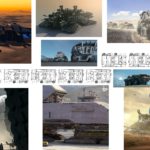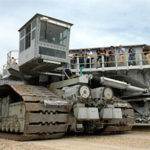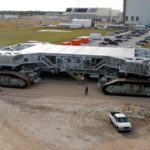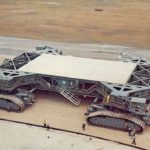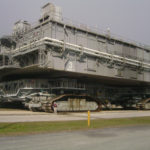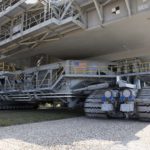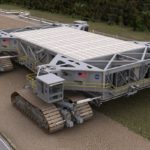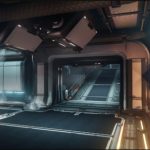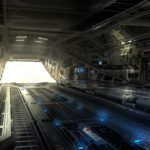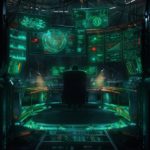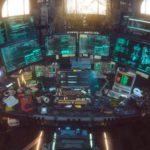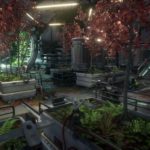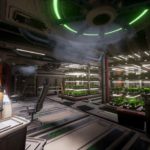“Land-train” was a term new and somewhat confusing to King Auz back when King Tiberius first spoke it. Auz’s first thought was, “Aren’t trains already land-trains?” The land-train concept would make more and more sense to him as his fellow King continued to explain…
–
Table of Contents:
- Intro
- Engineering Questions to Address
- Features All Land-trains Have
- The Start
- The Progression
- The Narrator/Prophet Tells of Their Time
- Overall
- It’s Been Done Before
- Bays & Hangars
- Command Rooms
- Onboard Farms
- Additional Notes
–
Intro:
It’s called a land-train because trains don’t actually move on the land; trains move on train-tracks, while a land-train moves over the ground itself. Like a train, a land-train is numerous train-cars linked together. A land-train is higher-up and tougher than a normal train, though; land-trains are designed for off-roading (sometimes called “overlanding”), and to be able to weather any storm, and defend themselves, if need be.
–
Engineering Questions to Address:
A train without tracks poses some new design challenges. First, it will have vibrations similar to turbulence; things inside must either be strapped down very well, or they must be on coils (like the container-modules in NORAD and similar blast-proofed facilities) so that they can shake without taking damage.
- how do we prevent the forge’s molten metal from sloshing around? only heat up the metal in its buckets when the land-train is parked?
- 3D-print (everything in one/each factory/facility) instead of (having/needing) multiple factory types (per land-train)?
- which materials and link-shapes/types are strong enough to keep multi-multi-ton vehicles connected during off-roading?
More TBA here…
–
Features All Land-trains Have:
- build and launch own tanks/aircraft
- runways on top, but most things have VTOL
- not tank-treads; those are difficult to reset/reattach; use air-less tires with tread designed to fall off, regrow from inside, etc.
- ability to defend every car (every “car” has gun turrets and countermeasures to defend itself)
- detach every car (automatically, rapidly, remotely; from a command “car”)
- quick-detach all; for evasion
- ability to “digest” scrap metal, other vehicles, etc.
- cranes retract inside tops; recoiled to prevent from hitting things or swaying loose during rough driving
- all vehicles can “crabwalk-drive”, and are NOT pulled by train-links around curves
It has been suggested that a convoy of vehicles following the lead-vehicle’s driving-path closely/exactly will reduce the risk/chance of one of them straying far enough to hit a landmine the others did not. The land-train design makes this automatic; as long as its “cars” are connected (and not moving semi-laterally via their “crabwalk” features; where all tires turn, instead of just the front-tires turning), every “car” in the train will go over the exact same terrain/spots.
If the lead vehicle (or any vehicle) takes landmine/IED/any damage, which would cause a mobility-kill (as opposed to a catastrophic-kill), the other vehicles in the land-train have enough momentum and power to push/pull that vehicle right along, none of them needing to stop to clear it out of the way, disable/destroy it, etc.
–
The Start:
Lord Auzdein von Himmler (a.k.a. King Auz) helped design the land-train(s)… based on a larger version of Inisfree’s “Work-horse” vehicles. The Work-horse vehicles were like MRAPs with more devices/tools on them; they had firetruck-ladders, cranes, street-sweeping mechanisms, braces to help prevent tipping, water-hoses, and more. Now imagine a dozen or more of them linked together to form a train that did not need any train-tracks to drive on.
–
The Progression:
2030s A.D.: The first land-train was the prototype, and its linked vehicles were just a few oversized dump-trucks once used in a major quarry. It stood a couple stories tall.
- Dump-truck 1
- Dump-truck 2
- Dump-truck 3
2040s: The second land-train saw those vehicles retrofitted with weapon systems, allowing them to take on drones simulating spying and attacks from the air. It stood a few stories tall.
- Weaponized Dump-truck 1
- Weaponized Dump-truck 2
- Weaponized Dump-truck 3
2050s: The third land-train had several vehicles linked together, all of them built custom from the start, and they looked more like an actual train, but of scaled-up MRAPs and other armored vehicles, not box-cars like you’d find on a normal train. It stood several stories tall (four-floored “cars” (counting their rooftop-level) that each had a three-story clearance beneath them), and was the first to try bringing mini-factories along with it. A grown man could stand with his arms stretched straight up beneath it, and it would drive over him without making any contact.
- Giant MRAP containing an armory
- Giant MRAP containing a command & control module; communication & navigation, etc.
- Giant MRAP containing a construction-specialists office
- Giant MRAP containing a mechanics shop/bay
- Giant MRAP containing a medical pod/suite
- Giant MRAP containing a military prison for POWs/detainees
- Giant MRAP containing a storage section; shipping-containers on multiple levels/floors
2060s: The fourth land-train variant (or “generation”) was almost ten stories tall (six-story “cars” with a four-story clearance), and it had a dozen vehicles linked, and could drive over a row of houses in a neighborhood without damaging them –though it would certainly leave “impressions” on their streets.
- House-sized MRAP containing Air-Traffic Control (ATC) plus drones (UAVs)
- House-sized MRAP containing an armory
- House-sized MRAP containing a command & control module; communication & navigation, etc.
- House-sized MRAP containing a construction-specialists office
- House-sized MRAP containing a mechanics shop/bay
- House-sized MRAP containing a medical pod/suite
- House-sized MRAP containing a Mess Hall (with food storage, cold storage, food prep’ areas, etc.)
- House-sized MRAP containing a military prison for POWs/detainees
- House-sized MRAP containing a mortarmen platoon (not quite artillery, but getting there)
- House-sized MRAP containing a science facility; laboratory and other modules for studying artefacts, wreckage, new lifeforms, etc.
- House-sized MRAP containing a storage section; shipping-containers on multiple levels/floors
- House-sized MRAP containing a water-harvesting/treatment plant
2070s: The fifth generation of land-trains had one building-sized “car” (like a train-car, except able to detach as its own vehicle (mobile building)) for each of the following fields or functions. It stood a dozen stories tall, and could drive over most buildings that were not high-rises (anything that was ~40’ tall; 4 stories).
- aircraft hangar (not just UAVs; piloted fighter-sized aircraft and helicopters)
- aircraft runway (rooftop)
- ATC tower
- berthing/quarters/barracks (bunks are on springs so they shake less while driving?)
- bridge/command
- clothing facility
- crane (with tower/pod)
- crops/farm; food-growing
- factory/assembly
- forge
- glass-plant
- gunner turrets (all auto, above AND below every car in the train, but all with room to be manned, and all controllable from the Bridge)
- hospital/medical
- labs (medical, R+D, etc.)
- laundry facility/room
- Mess Hall
- mining ***and the big mountain-processing/carving buckets-wheel on front?
- MWR –including brothel/s
- plastics-plant
- prison/interrogations
- quarantine/HAZMAT
- refinery/ies -one for oil? -one for ore into metal/s?
- sand tanks/containers (for making glass, etc.)
- studio –for editing drone- and helmet-cam footage into AAR videos and updates/YouTubes for the survivors in the remote bases
- tires-plant
- tanks bay (or ALL-vehicles bay –and all are amphibious)
- with ramps between the tires, allowing them to deploy while the land-train is moving
- and ramps that lower from the sides
- and cranes that take vehicles from the side hangars/bays/parking, and hold them over the terrain, letting them spin their wheels/treads before being lowered and released
- warehouse
- waste treatment/ejection
- water treatment/recycling -reverse osmosis, desalination, atmosphere-condensing, etc.
- weapons forge
- weapons storage (near core? or away from engine/berthings?)
2080s: The sixth generation had all of those things in each of its “cars”; every building linked in these new land-trains could do everything a whole land-train could do, albeit on a slightly-smaller scale; even though its cars were another story or two taller than the previous generation’s, it was packing three-dozen different facilities into each one, filling up all their levels and spaces. This allowed any part of these land-trains to separate, start another land-train, or even survive on its own, as if it was a complete outpost, research station, or Forward-Operating Base (FOB).
2090s: The seventh generation would be amphibious. Picture dozens of LAVs or other armored amphibious vehicles, each ~10x larger than the original.
2100s A.D.: The eighth would have hovering options, if not be fully flight-capable. It would essentially be dozens of gigantic LCAC-5s.
2110s: The ninth would likely be able to go into Space (or drive around as a land-train on moons and other worlds with less/no atmosphere).
2120s: The tenth was envisioned as having warp-drives; it would be able to bend Space around it, no longer having to drive/move like a train at all. Imagine this: You build a land-train (mobile set of factories and other facilities, or even like a mobile colony)… and then you shrink the distance between where it is… and where you want it to do work or build things, turning off its warp-drive once the location appears under/around it. Now you have a mobile colony, complete with many different kinds of buildings, already out there in an instant, ready to move however might be needed, no matter if a flood, storm, or anything else comes its way. (And later upgrades to this technology would allow for more/farther bending of Space; you could warp it over to other worlds, not just to other parts of the world it was made/left on.)
*2023 September update: Obviously, warp/bend-based technology is limited to line of sight when on a planet, otherwise you could rip miles-wide cavern-tunnels through terrain, or release new volcanic forces from the core, so these vehicles would sometimes warp up to high plateaus or wide summits they could see, increasing their line-of-sight, and then proceed to the next-farthest thing they could see, or just aim at the Moon, warping anywhere on its facing-surface.
~200 years would then pass as those land-train generations were used, all of them operating at once, none of them allowed to fall into museum-level disuse. 200 years of R+D for them and so many other things would follow. And the restored-lifespans of the people still on Earth allowed it; they now lived long enough to see and contribute to it all.
–
The Narrator/Prophet Tells of Their Time:
It was some hundreds of years after the 39 rebuilt cities had spread out again, growing into the mega-cities of the era of Judge Dredd, and it was dozens of years after 99% of mankind had been forcibly deported from the planet once and for all; their coastline-spanning and state-sized super-cities were all still there, now empty, in ruins, free for the taking… Free for the salvaging. (2340s A.D.)
Between them were the radiated wastes; desertification had claimed the rest of the planetary terrain between them, and had little life or resources to speak of; only sandstorm- and dust-storm-buried ruins (such as interstate highways and nuclear missile silo complexes) remained. It was a damning expanse in every direction. One had to take a lot of supplies, armor, and teammates to survive.
Some of the 39 exemplary humans chosen to lead the rebuilding of those now-emptied 39 cities had chosen to stay on Earth in spite of its vast and lethal wastes, their efforts to guide humanity back on a good path, harmonious with nature, recognized by the Inisfreeans; the Inisfreeans had permitted them to stay as they pleased. Gabriel Tiberius was one of those 39 men. He had once been the king of New California. Now… he was the commander of the land-train that nation-state had built.
In time, he would venture out into Space, reaching and charting worlds of his own. For now, he was still being a pioneer on his home-world. King Tiberius was now more than a city-state manager and founder of new Spartan units; in this Age, he was leveling-up from projects the size of rebuilt cities spread out across big states… to projects spanning continents that no longer had nations to tame them.
Out in the wastes between the cities, military bases had been established as emergency refueling way-stations for the land-train and similar expedition vehicles. Those were largely abandoned, too, but King Tiberius’s men (some of the last ones allowed to remain on the planet after the global deportation purge of 2313) still worked out there… like warrior-monks… manning those remote facilities for as long as the land-train was destined to roam.
The convoys of the modern Exodus had involved millions of people back in the early decades of the 21st century; one million per continent had eventually awoken and found each other, then leaving with their vehicles, en masse. This had created major congestion problems along the few highway-based routes available to them back then, most of their cars and trucks not rated for overlanding. Towing downed vehicles also became a problem, as most were already overburdened with fuel canisters and other supplies. Thus, the land-train was born.
It had been a concept on a few minds for some years leading up to that exodus, but only when the many minds participating experienced first-hand its need… did they begin to focus themselves as one… upon it. That was what led to all the resources and knowhow being combined to make the first prototype, and it had been an impressive one; dozens of custom dump-trucks retrofitted with new tech’ all moving as one, no longer needing any highway or other roads, and able to get past some of the smaller canyons and crevasses –plus able to keep pushing and pulling their own, not having to leave anyone behind (like those huge exodus convoys often had).
Those first land-trains were only a few stories tall, and they were used between the 39 cities getting rebuilt after the Rapture had wiped all other civilization away. Over the decades, the trade they restored… allowed those cities to keep growing as fast as they did, leading to the city-states and mega-cities, and then to bigger land-trains, each generation of that technology growing more resilient, hardened against the harsh “world” out between the now state-sized metropolises. There was a time when dozens of land-trains patrolled (and provided relief-supplies to) the abandoned wastes between the rebuilt cities; those were the lands where nations of cities and towns once had been.
Eventually there was a land-train that could straddle high-rise buildings between its tires; its clearance was several stories up off the ground, its roof… another several stories higher. This land-train could drive over forests without knocking down their trees, and cross even gaps such as the Grand Canyon without too much strain. It was the one King Tiberius now rode in, commanding it from the very front and top, just like all real kings do.
Without having to stop, King Tiberius could deploy vehicles and aircraft from his land-train. He could even disregard fields of land-mines in it, never having to change a tread or tire. The thing took a beating as if it was merely breathing, and carried on, rumbling reliably from horizon to horizon, only having to take its time in narrow mountain passes, and always getting through.
This Titan of the land-trains was what brought enough resources, facilities, and manpower out to all the region-spanning mega-city ruins, allowing those aboard to investigate, dismantle, and salvage or recycle them all. They brought down skyscrapers and skyscraper-tall walls with that thing, sometimes even finding enough useful scraps to leave brand-new land-trains in their wake.
With all the new bodies of water the size of lakes and seas, so many areas having been flooded from the pole-shift the Inisfreeans triggered after they’d chased all the humans out of their mega-cities and down into Space (since the Inisfreeans see Space as down, and the core of the Earth as up), and with all the new mountain-range-sized piles of sand, mud, silt, and debris left compressing and hardening into new plains and plateaus atop the remains of those human-civilization zones, only that latest and greatest land-train could make it out there and back with confidence and safety, unaffected by all the quick-sand, sink-holes, and other hidden underground death-traps that plucked away untold numbers of individuals and normal vehicles right out from under their feet.
As the months of that giant land-train’s use went on, inevitably turning into its first years, its operators soon mastered the art of using it to build defensive walls a few stories tall as it passed overhead, providing total shelter from the still-strong winds and sometimes-acid rains. It was also able to create trenches and moats just via the weight of its building-sized tires (at least where the ground was still semi-flooded and soft, that is, but always wherever the land-train’s artillery pummeled the soil until it was rows of craters, ready for the reshaping). This lead to walls erected in record time, and across entire valleys, riverbanks, and other points of movement and concern, all of them too tall for anyone without special climbing gear (or aircraft) to scale, leaving better-controlled counties and districts-to-be in the Californian King’s dust, which more of his new-Spartan forces would be sent to.
Where King Tiberius went with that land-train of his, giant walls were erected, river-sized moats were formed, cliffs were turned into staircases, and canyons were beaten into natural bridges and dams. Entire mountain ranges were mined for all their resources by the time the seasons changed. Floodplains were ignored, and countless stranded Outlanders were spotted and saved –growing his Spartan units by a degree of magnitude, so many of them impressed and grateful enough to enlist.
When the Prophet visited him (from his Own mighty invented vehicles and city-start faraway), they reminisced on the times they had walked across rivers in narrow canyons together, hiking up cliff staircases, and daring down into multi-story caves. Speaking of these things amongst their commanders and other men, they raised toasts with the goblets his land-train’s forge had made, and laughed loudly like lions like those two always do. Over the sheer sides of their land-train, another river –two stories deep– was being driven over and through by the land-train tires… as easily as they had walked and waded through The Narrows of Zion Park just up its way past the Court of the Patriarchs.
“To paradise and beyond!” they raised their goblets, fashioned in King Tiberius’s land-train forge from a fresh batch of ore from one of the mountain veins now back over the horizon behind them. Their Spartan commanders and other heroes with them raised their own goblets and cheered, “To paradise and beyond!” These were good years. Phase Three was here.
–
Overall:
–
It’s Been Done Before:
–
Bays & Hangars:
–
Command Rooms:
–
Onboard Farms:
–
Additional Notes:
Land-trains are manufactured in 1) King Tiberius’s military factories in New California, and 2) King Auz’s (3D-printing) Military-vehicles Factory in Inisfree. They are stored/parked 1) wherever King Tiberius needs them, and 2) in King Auz’s (Inisfree’s) “White Rhinos” Motor-pool. King Auz sends them to the Outlands (the lands outside Inisfree) for King Tiberius via the lanes-wide portal in Inisfree’s Highway Pyramid.
In the near future, King Tiberius will also commission the building of a starship called Lakonia, named after the famous ship and location in Greece. The Inisfreeans will help him (his workers) build it, using much of what was learned when the Leviathans were built before (and in preparation for) The Shift and The Rapture. The Lakonia will be big enough to transport numerous land-trains in it to other worlds (and some of the smaller/older land-trains can be transported (with their “cars” unlinked, of course) in the bigger/newer land-trains aboard it). While the Lakonia is in transit to other worlds, the land-trains that can bend Space will transport themselves (again, sometimes while bringing the smaller/older land-trains with them, via their biggest bays/hangars).
–
